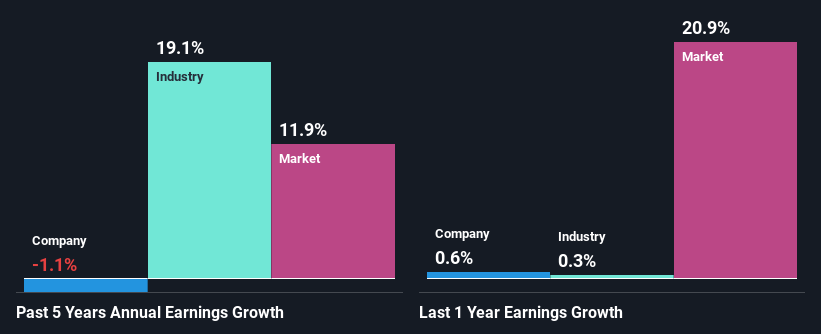Pfizer Inc. (NYSE:PFE) Is Going Strong But Fundamentals Appear To Be Mixed : Is There A Clear Direction For The Stock?
Most readers would already be aware that Pfizer's (NYSE:PFE) stock increased significantly by 16% over the past three months. However, we wonder if the company's inconsistent financials would have any adverse impact on the current share price momentum. Particularly, we will be paying attention to Pfizer's ROE today.
Return on equity or ROE is a key measure used to assess how efficiently a company's management is utilizing the company's capital. In simpler terms, it measures the profitability of a company in relation to shareholder's equity.
View our latest analysis for Pfizer
How Do You Calculate Return On Equity?
The formula for ROE is:
Return on Equity = Net Profit (from continuing operations) ÷ Shareholders' Equity
So, based on the above formula, the ROE for Pfizer is:
14% = US$9.4b ÷ US$69b (Based on the trailing twelve months to April 2021).
The 'return' refers to a company's earnings over the last year. Another way to think of that is that for every $1 worth of equity, the company was able to earn $0.14 in profit.
Why Is ROE Important For Earnings Growth?
So far, we've learned that ROE is a measure of a company's profitability. We now need to evaluate how much profit the company reinvests or "retains" for future growth which then gives us an idea about the growth potential of the company. Generally speaking, other things being equal, firms with a high return on equity and profit retention, have a higher growth rate than firms that don’t share these attributes.
Pfizer's Earnings Growth And 14% ROE
At first glance, Pfizer seems to have a decent ROE. Yet, the fact that the company's ROE is lower than the industry average of 23% does temper our expectations. Additionally, the flat earnings seen by Pfizer over the past five years doesn't paint a very bright picture. Not to forget, the company does have a decent ROE to begin with, just that it is lower than the industry average. So there might be other reasons for the flat earnings growth. For example, it could be that the company has a high payout ratio or the business has alloacted capital, for instance.
As a next step, we compared Pfizer's net income growth with the industry and discovered that the industry saw an average growth of 19% in the same period.
The basis for attaching value to a company is, to a great extent, tied to its earnings growth. The investor should try to establish if the expected growth or decline in earnings, whichever the case may be, is priced in. Doing so will help them establish if the stock's future looks promising or ominous. One good indicator of expected earnings growth is the P/E ratio which determines the price the market is willing to pay for a stock based on its earnings prospects. So, you may want to check if Pfizer is trading on a high P/E or a low P/E, relative to its industry.
Is Pfizer Making Efficient Use Of Its Profits?
The high three-year median payout ratio of 80% (meaning, the company retains only 20% of profits) for Pfizer suggests that the company's earnings growth was miniscule as a result of paying out a majority of its earnings.
In addition, Pfizer has been paying dividends over a period of at least ten years suggesting that keeping up dividend payments is way more important to the management even if it comes at the cost of business growth. Upon studying the latest analysts' consensus data, we found that the company's future payout ratio is expected to drop to 53% over the next three years. As a result, the expected drop in Pfizer's payout ratio explains the anticipated rise in the company's future ROE to 22%, over the same period.
Summary
On the whole, we feel that the performance shown by Pfizer can be open to many interpretations. Specifically, the low earnings growth is a bit concerning, especially given that the company has a respectable rate of return. Investors may have benefitted, had the company been reinvesting more of its earnings. As discussed earlier, the company is retaining a small portion of its profits. Having said that, looking current analyst estimates, we found that the company's earnings growth rate is expected to see a marginal improvement. To know more about the latest analysts predictions for the company, check out this visualization of analyst forecasts for the company.
This article by Simply Wall St is general in nature. It does not constitute a recommendation to buy or sell any stock, and does not take account of your objectives, or your financial situation. We aim to bring you long-term focused analysis driven by fundamental data. Note that our analysis may not factor in the latest price-sensitive company announcements or qualitative material. Simply Wall St has no position in any stocks mentioned.
Have feedback on this article? Concerned about the content? Get in touch with us directly. Alternatively, email editorial-team (at) simplywallst.com.


